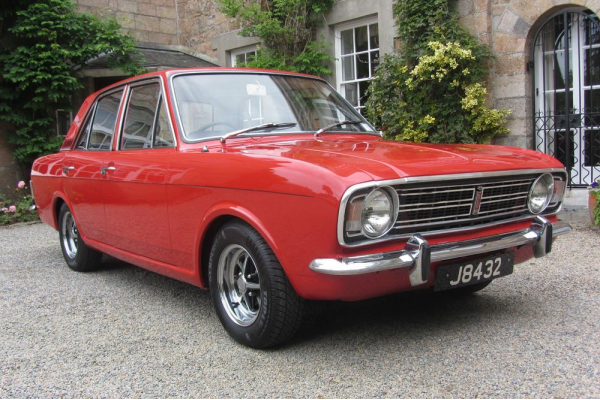
Why you’d want a Lotus Cortina Mk1
When it was first announced in The Motor in January 1963 as ‘A ravening wolf in slightly sheepish clothing’, the Lotus-modified Ford Cortina was to be sold through Ford dealers as ‘The Consul Cortina Sports Special’.
Walter Hayes at Ford saw the potential sales benefits in a successful British Saloon Car Championship campaign, and Lotus could see the race potential in Ford’s everyman saloon, with its light, stiff monocoque shell, MacPherson strut front suspension and highly tunable oversquare engine.
Lotus and Cosworth had made the Anglia 105E motor dominant in Formula Junior, and Lotus had commissioned Harry Mundy to design a twin-cam head for the Consul Classic engine (which Ford conveniently enlarged to 1498cc just in time for the new Lotus Elan): it was a marriage made in heaven.
The Lotus Cortina was assembled by Lotus and was an instant success, resulting in Jim Clark (who had played an important role in developing and testing the car) winning the British Saloon Car Championship in 1964; Ford couldn’t have hoped for more.
Jim Clark races a Lotus Cortina at Snetterton in the 1966 BSCC
Unsurprisingly, as a production road car it had its share of quality issues, especially the alloy diff housing coming away from the axle casing due to the cornering loads inflicted by the Lotus A-frame location.
From June 1964, once 1000 (or so) had been built for homologation, the aluminium parts were swapped for Ford production items and the price was reduced from £1100 to £992 – so the earliest examples are now more desirable, even if they were not the most reliable when new.
With so many raced, crashed, rotten and reshelled, and replicas created from no more than a logbook and a two-door shell, buying a Lotus Cortina is a minefield that should be negotiated with great caution.
Join the Lotus Cortina Register and get help to check provenance before buying: a reshelled car or a replica, if done properly, is every bit as fun (and less of a tragedy if raced and crashed), but is worth substantially less than an original car with full history.
Details such as boot mountings for the spare wheel and battery, servo mounting in the engine bay or braces for the rear suspension are check points, but you need to know how Ford/Lotus built the originals to confidently identify one: www.lotuscortinainfo.com is a big help.
Images: Will Williams
Lotus Cortina Mk1: what to look for
Charmingly described in The Motor as ‘a good compromise for a keen driver who has to remember that the family must sit somewhere’, the Lotus Cortina is still an exhilarating drive, with torquey, lively acceleration, firm handling, adequate brakes, excellent visibility and, in Aeroflow form, good ventilation.
Bodywork
See above for trouble spots
Engine
The Twin Cam is an excellent engine, but needs careful setting up and thorough maintenance. Check for oil in the water and vice versa, for leaks from the water pump, oil leaks, excessive breathing, a rattly timing chain or knocks from the bottom end. Oil pressure hot should be 10-15psi at tickover, 40-plus at speed.
Suspension
Lower front suspension shared few parts with standard cars, with stiffer springs/dampers, longer forged track-control arms and thicker anti-roll bar.
Gearbox
Gearbox ratios changed three times in production, and few are original. Check that the synchromesh still functions and bearings aren’t growling.
Interior
Lotus designed improved front seats, while the steering wheel, dashboard, instruments and centre console were special, too: original parts are rare.
Authenticity
The chassis number was stamped into the MacPherson strut top (here on a different car), though most will have been cut out or plated over.
Lotus Cortina Mk1: on the road
Other liveries were available, but the Lotus Cortina is most famous in its distinctive white with green side flashes and simple steel wheels
With a five-bearing crank and oversquare dimensions, the Twin Cam is long-lived if well maintained. The water pump is a weak point (rock the pulley, there should be no play) and if it’s been run dry after water-pump failure, the head may be warped. Corrosion damage also wreaks havoc with heads.
Super unleaded fuel is needed to avoid pinking: if it still pinks, the head may have been skimmed too far. If the timing-chain adjuster is screwed almost fully in, a new chain is needed.
Webers are reliable once set up: the original airbox is rare and sought after. The close-ratio Elan gearbox fitted until late 1964 was great for racing, but not so good for normal road use where a wider spread of gears is desirable. All had a slick change and synchromesh on all four ratios, so check that the synchros are good and that the bearings aren’t getting noisy (dip the clutch in neutral to see if there is a noise that goes away).
Early cars featured aluminium doors, bonnet, bootlid, diff housing, gearbox extension, remote control and bellhousing, plus coil-sprung rear suspension with A-frame location, and shorter steering arms combined with a quick steering box. With the Lotus Cortina’s value today, most have been reproduced but sourcing original factory parts, if preferred, is hugely expensive. Later examples lost these unique components so are cheaper to restore, but a little heavier and less nimble – and significantly less valuable, despite being better suited to normal road use.


